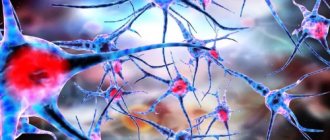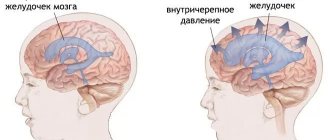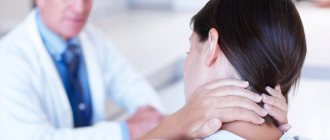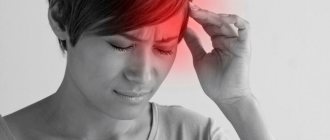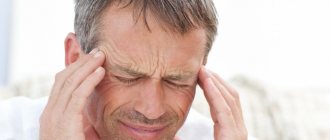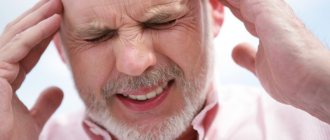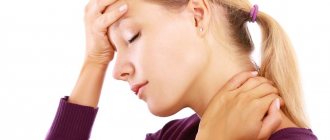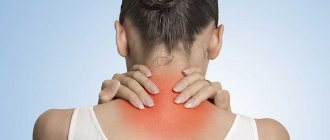general information
The trigeminal nerve consists of sensory and motor fibers. It originates in the structures of the brain and is divided into three branches:
- ophthalmic: responsible for the eye, forehead and upper eyelid;
- maxillary: innervates the area from the lower eyelid to the upper lip;
- mandibular: involves the chin, lower jaw, lips and gums.
With neuralgia, one or more branches of the trigeminal nerve are affected, which determines the main symptoms of the pathology. People over 45 years of age are most susceptible to the disease, and women get sick more often than men.
Make an appointment
Causes
The causes of trigeminal neuralgia can be of different nature:
- compression of the entire trigeminal nerve or its branches against the background of: enlargement of the arteries or veins of the brain (aneurysms, atherosclerosis, strokes, increased intracranial pressure due to osteochondrosis, congenital developmental features);
- tumors of the brain or facial tissues in close proximity to nerve fibers;
- congenital anomalies of bone structure, narrowed openings through which nerve branches pass;
- injuries of the skull, facial area: bone fractures, post-traumatic scars of soft tissues;
- proliferation of scar tissue after injury, surgery, inflammation;
The risk of developing trigeminal neuralgia increases significantly:
- over the age of 50;
- against the background of mental disorders;
- with regular hypothermia;
- with insufficient intake of nutrients and vitamins into the body (anorexia, bulimia, malabsorption, etc.);
- with regular overwork, stress;
- for helminthic infestations and other helminthiases;
- for acute infections: malaria, syphilis, botulism, etc.;
- for chronic inflammation in the oral cavity (caries, gingivitis, abscesses, etc.);
- against the background of autoimmune lesions;
- with excessive exposure to allergies;
- for metabolic disorders.
Arteritis of the temporal region
Arteritis is an inflammatory disease of the arteries.
A rather rare disease in which a small lump forms on the temple, hurts when pressed and pulsates. It occurs most often in people over fifty years of age. The appearance of arteritis in young people is possible in isolated cases only in the presence of a genetic predisposition.
Arteritis is treated by a neurologist, surgeon, and therapist. At the same time, the patient may suffer from migraines, a feeling of fluid accumulation in the brain, and surges in blood pressure.
Symptoms
The main characteristic symptom of trigeminal neuralgia is paroxysmal pain. It comes suddenly and in its intensity and speed of spread resembles an electric shock. Typically, intense pain forces the patient to freeze in place, waiting for relief. The attack can last from a few seconds to 2-3 minutes, after which there is a period of calm. The next wave of pain may come within hours, days, weeks or months.
Over time, the duration of each attack of neuralgia increases, and periods of calm are reduced until a continuous aching pain develops.
The provoking factor is irritation of trigger points:
- lips;
- wings of the nose;
- eyebrow area;
- middle part of the chin;
- cheeks;
- area of the external auditory canal;
- oral cavity;
- temporomandibular joint.
A person often provokes an attack when performing hygiene procedures (combing hair, caring for the oral cavity), chewing, laughing, talking, yawning, etc.
Depending on the location of the lesion, the pain takes over:
- the upper half of the head, temple, orbit or nose if the ophthalmic branch of the nerve is affected;
- cheeks, lips, upper jaw – if the maxillary branch is affected;
- chin, lower jaw, as well as the area in front of the ear - with neuralgia of the mandibular branch.
If the lesion affects all three branches or the nerve itself before it is divided, the pain spreads to the entire corresponding half of the face.
Painful sensations are accompanied by other sensory disturbances: numbness, tingling or crawling sensations. Hyperacusis (increased hearing sensitivity) may be observed on the affected side.
Since the trigeminal nerve contains not only sensory, but also motor pathways for the transmission of impulses, with neuralgia the corresponding symptoms are observed:
- twitching of facial muscles;
- spasms of the muscles of the eyelids, masticatory muscles;
The third group of manifestations of neuralgia are trophic disorders. They are associated with a sharp deterioration in blood circulation and lymph outflow. The skin becomes dry, begins to peel, and wrinkles appear. Local graying and even hair loss in the affected area is observed. Not only the scalp suffers, but also the eyebrows and eyelashes. Impaired blood supply to the gums leads to the development of periodontal disease. At the time of the attack, the patient notes lacrimation and drooling, swelling of the facial tissues.
Constant spasms of muscle fibers on the diseased side lead to facial asymmetry: narrowing of the palpebral fissure, drooping of the upper eyelid and eyebrow, upward movement of the corner of the mouth on the healthy side or drooping on the diseased side.
The patient himself gradually becomes nervous and irritable, and often limits himself to food, since chewing can cause another attack.
Diseases of the cardiovascular system
Unstable functioning of the heart and blood vessels is a common cause of headache when pressed. These are serious conditions in which self-medication is unacceptable and consultation with a cardiologist is necessary. Does your temple on the right side hurt when pressed and do you feel pulsation of the veins? Most likely the cause is arrhythmia. This condition also often causes dizziness, darkening of the eyes, and short-term fainting. The patient feels weak and nauseated. Does your temple on the left side hurt when you press? Perhaps the reason is surges in blood pressure. It must be measured regularly to rule out hypertension.
With the combination of all these symptoms, we can talk not only about arrhythmia, but also about angina pectoris and cardiomyopathy. When blood pressure rises, the nature of the pain in the temples is stabbing or throbbing. If the indicators are lowered, then nagging discomfort, dizziness appears, and a short-term loss of consciousness may occur.
In some cases, problems with the functioning of the cardiovascular system are caused by changes in atmospheric pressure, weather changes, and chronic stress. This condition cannot be left to chance. It can lead to chronic diseases of the heart and blood vessels.
Diagnostics
A neurologist diagnoses trigeminal neuralgia. During the first visit, he carefully interviews the patient to find out:
- complaints: nature of pain, its intensity and localization, conditions and frequency of attacks, their duration;
- medical history: when pain attacks first appeared, how they changed over time, etc.;
- life history: the presence of chronic diseases, previous injuries and operations is clarified, special attention is paid to dental diseases and interventions.
A basic examination includes assessing the condition of the skin and muscles, identifying asymmetry and other characteristic signs, checking the quality of reflexes and skin sensitivity.
To confirm the diagnosis, the following is carried out:
- MRI of the brain and spinal cord with or without contrast: allows you to identify tumors, consequences of injuries, vascular disorders; sometimes the study is replaced by computed tomography (CT), but it is not as informative;
- electroneurography: study of the speed of nerve impulse transmission through fibers; allows you to identify the fact of nerve damage, assess the level of the defect and its features;
- electroneuromyography: not only the speed of impulse passage along the nerve bundle is studied, but also the reaction of muscle fibers to it; allows you to assess nerve damage, as well as determine the sensitivity threshold of trigger zones;
- electroencephalography (EEG): assessment of the bioelectrical activity of the brain.
Laboratory diagnostics includes only general studies to exclude other causes of painful attacks, as well as to assess the condition of the body as a whole (usually a general blood and urine test is prescribed, as well as a standard set of biochemical blood tests). If the infectious nature of the disease is suspected, tests are carried out to identify specific pathogens or antibodies to them.
Additionally, consultations with specialized specialists are prescribed: ENT specialist (if there are signs of nasopharynx pathology), a neurosurgeon (if there are signs of a tumor or injury), and a dentist.
When you need to see a doctor urgently
Although in most cases, headaches after coronavirus are only an unpleasant, but not dangerous consequence of an infection, it would be a mistake to take them lightly, especially in the presence of concomitant cardiovascular diseases. Therefore, patients from this risk group need to be examined by a neurologist as soon as possible if headaches occur after coronavirus. But if the following symptoms appear, you should urgently seek medical help:
- slurred speech, smiling from only one corner of the mouth, unilateral movement disorders;
- sharp thunder-like headache;
- saturation less than 93% with repeated measurements;
- severe dizziness, loss of consciousness;
- impaired coordination of movements, balance.
Treatment of trigeminal neuralgia
Treatment is aimed at:
- to eliminate the cause of damage;
- to alleviate the patient's condition;
- to stimulate the restoration of nerve structures;
- to reduce the excitability of trigger zones.
Properly selected treatment can reduce the frequency, intensity and duration of pain waves, and ideally achieve stable remission.
Drug treatment
Trigeminal neuralgia requires complex treatment using drugs from several groups:
- anticonvulsants (carbamazepine and analogues): reduce the excitability of nerve fibers;
- muscle relaxants (baclofen, mydocalm): reduce muscle spasms, improve blood circulation, reduce pain;
- B vitamins (neuromultivit, milgamma): stimulate the restoration of nerve fibers, have an antidepressant effect;
- antihistamines (diphenhydramine): enhance the effect of anticonvulsants;
- sedatives and antidepressants (glycine, aminazine): stabilize the patient’s emotional state.
For severe pain, narcotic analgesics may be prescribed. Previously, drug blockades (injecting the problem area with anesthetics) were actively used, but today this method of treatment is almost never used. It contributes to additional damage to nerve fibers.
Treatment of the root cause of the disease is mandatory: elimination of dental problems, taking medications to improve cerebral circulation, etc.
Physiotherapy and other non-drug methods
Non-drug methods complement drug therapy well and help stabilize patients’ condition. Depending on the condition and concomitant diseases, the following may be prescribed:
- ultraviolet irradiation: inhibits the passage of impulses along nerve fibers, providing an analgesic effect;
- laser therapy: reduces pain;
- UHF therapy: improves microcirculation and prevents muscle atrophy;
- electrophoresis with analgesics or antispasmodics to relieve pain and relax muscles;
- diadynamic currents: reduce the conductivity of nerve fibers, significantly increase the intervals between attacks;
- massage of the face, head, cervical-collar area: improves blood circulation and lymph outflow, improving tissue nutrition; must be carried out with caution so as not to touch trigger zones and provoke an attack; the course is carried out only during the period of remission;
- acupuncture: helps relieve pain.
Surgery
The help of surgeons is indispensable when it is necessary to eliminate nerve compression. If indicated, the following is carried out:
- removal of tumors;
- displacement or removal of dilated vessels pressing on the nerve (microvascular decompression);
- expansion of the bone canals in which the branches of the nerve pass.
A number of operations are aimed at reducing nerve fiber conductivity:
- exposure to a gamma knife or cyber knife;
- balloon compression of the trigeminal node: compression of the node using an air-filled balloon installed in close proximity to it, followed by death of the nerve fibers; surgery often leads to partial loss of sensation and decreased muscle movement;
- resection of the trigeminal node: rarely performed due to the complexity and large number of complications.
Make an appointment
Local diseases
If it hurts just below the temple when pressed (the sensation is not located in the temple itself, but next to it), then most likely the cause is local diseases. These are meningitis, sinusitis, inflammation of the nasopharynx and sinuses, ARVI, and other infectious diseases. This is due to an increase in temperature and the accumulation of mucus in certain parts, which with its volume puts pressure on the tissues of the skull.
To treat such conditions, antiviral and immunomodulatory drugs should be used. These are “Kagocel”, “Sinupret”, “Arbidol” and others. An immunologist can prescribe a medicine that would be ideal for a particular patient and does not cause side effects.
If the temple on the right side hurts when pressed (at the same time there is nasal congestion, sore throat, swollen lymph nodes and other symptoms of ARVI and influenza), then the inflammatory process occurs on the right side of the nasopharynx, tonsils and sinuses. It is necessary to more actively use medicinal aerosols and sprays specifically for the treatment of the right nostril and the side of the throat. Does your temple on the left side hurt when you press? Accordingly, the inflammatory process is more active on the left.
Complications
Without treatment, trigeminal neuralgia gradually progresses. Over time, a pathological pain focus forms in one of the parts of the brain. As a result, the pain covers the entire face, is provoked by any minor irritant and even the memory of an attack, and subsequently becomes permanent. Vegetative-trophic disorders progress:
- irreversible atrophy of the facial muscles is formed;
- teeth become loose and begin to fall out due to advanced periodontal disease;
- baldness is increasing.
Due to constant pain, the patient's sleep is disturbed and severe depression develops. In severe cases, patients may commit suicide.
First aid when the left temple of the head hurts
Every person probably knows why self-medication should not be done. However, if it is not possible to see a doctor immediately, then you need to help yourself:
- You can use antispasmodic drugs that will help eliminate pain on the left side of the head. However, this is done if the patient knows his diagnosis accurately.
- Massage of the neck and head makes it possible to relieve pressure and pain that radiates to the eye.
- Pain in the left temple can be removed with a cold compress, lemon peels, cabbage leaves.
- If the patient experiences discomfort as a result of an excessive decrease in pressure, then simply drink a cup of coffee.
Find out what pills you can take for headaches.
Such methods of eliminating pain syndromes are good if it appears once and does not recur often. If it is felt constantly, the patient has a shooting in the ear or temple, then you need to find out as quickly as possible why such a pathological condition appeared and begin its therapy.
Prevention
Prevention of trigeminal neuralgia is a set of simple measures that significantly reduce the risk of developing pathology. Doctors recommend:
- undergo regular preventive examinations;
- at the first signs of the disease, seek help (the sooner treatment is started, the greater its effect will be);
- eat right, get the required amount of vitamins, minerals, unsaturated fatty acids;
- regularly engage in light sports and gymnastics;
- get enough sleep and rest;
- minimize stress and physical overload;
- avoid hypothermia and harden yourself;
- to refuse from bad habits.
Treatment at the Energy of Health clinic
If you or your relative are bothered by severe pain in one or another part of the face, the neurologists of the Health Energy clinic will come to the rescue. We will conduct a full diagnosis to identify the causes of the pathology and prescribe comprehensive treatment. At your service:
- modern drug regimens to reduce the frequency and intensity of attacks;
- physiotherapeutic procedures: magnetotherapy, laser therapy, electrophoresis, phonophoresis, etc.;
- delicate therapeutic massage;
- acupuncture;
- help from a psychologist if necessary.
Hormonal disorders
If a woman has pain near her temple when pressed, then perhaps it is due to diseases of the hormonal system. With thyrotoxicosis, the symptoms are varied - migraines and pain in the back of the head and temples when pressed can occur. If there is a deviation in TSH levels, hair loss (alopecia), asthenia, dysphoria, irritability, and anxiety are also possible.
Another reason why temples hurt when pressed is premenstrual syndrome. This condition is not a disease and occurs in approximately 30% of women aged 16 to 43 years. To avoid it, before the onset of menstruation, you should rest more, avoid physical activity, hypothermia, and stress. In some cases, a course of vasodilator drugs will help. A prescription for such medications can be obtained from a neurologist.
Advantages of the Health Energy Clinic
The Health Energy Clinic is a multidisciplinary medical center where every patient has access to:
- screening diagnostic programs aimed at early detection of diseases and pathologies;
- targeted diagnostics using modern equipment and laboratory tests;
- consultations with experienced specialists, including foreign ones;
- modern and effective comprehensive treatment;
- necessary certificates and extracts;
- documents and appointments for spa treatment.
Trigeminal neuralgia is a serious pathology that can seriously disrupt a person’s normal lifestyle. Don't let pain and fear take over your thoughts, get treatment at Health Energy.
